Hotel Confirmed as Everton F.C.’s first headquarters and the birthplace of big-time football on Merseyside
Everton F.C.’s first secretary was the younger 26 years old John William Clarke, and not his landlord father John, who, down the years, had often been incorrectly credited with having had that historic role
The Queen’s Head Hotel has become part of Everton folklore regarding the events that took place within its walls and the decisions made that laid down the foundation of Everton Football Club. This historic venue is where St Domingo’s Football Club became Everton Football Club in November 1879, and in 2015 the site was uncovered for the first time in almost half-a-century.
Ken Rogers, former Sports Editor of the Liverpool Echo, and member of Everton FC Heritage Society, was determined to discover more about the site, and to see if an excavation could be organised to reveal more of the history of the Queen’s Head Hotel. Below, Ken takes up the story.
Queen’s Head Hotel Archaeological Excavations
Ken Rogers
I. Digging For Our Roots

The house on the left, directly opposite the cross, is where Molly Bushell, the inventor of Everton Toffee, lived. The first cottage on the right is ‘Prince Rupert’s Cottage’, where folklore records that is where the Prince resided during the Civil War Siege of Liverpool. The Queen’s Hotel is roughly halfway up the block on the right.
As a journalist and author, I’m well aware that once an incorrect fact gets into a publication it can easily be repeated down the years in subsequent titles. Things that were not quite right can subsequently become irrefutable facts.
To go back to the very beginning and to focus the hearts and minds of some key people who I knew could help me, I decided that we needed to do more than just dig for new information. We needed to literally dig for history and this entailed persuading the respected archaeological team at the Museum of Liverpool to consider a full scale excavation of the Queen’s Head Hotel site where the Everton FC story began. To ensure I would get a positive response to my unusual request, I began to investigate the building’s relevance, not just through previous football books, but by studying Victorian maps, images and plans and, more importantly, the official census records closest to 1879 that would not only reveal who lived at the Queens Head Hotel at that time, but also information about its neighbours, the other businesses in the village, and the characters who would have been patrons of this heartland Everton pub.
This would all help in our quest to take a football time machine journey back to 1879. Sadly, there is not a single property still standing on Village Street following the 1960s slum clearances, but intriguingly the road itself is still in situ, effectively the southern boundary of the modern Everton Park.
I made an appointment with Dr Mark Adams, then lead archaeologist at the Museum of Liverpool, to enthuse him about the site and its place in local football history. It took just a couple of minutes for him to grasp its importance and within a matter of weeks we had agreed a date for a full scale excavation of the Queen’s Head site . . . Saturday 18 July 2015. This event would be fully supported by the respected Everton FC Heritage society of which I am a member.
Dr Adams immediately visited Village Street to understand the lie of the land. The shape of the street has remained unchanged for over 200 years, wider at the top than the bottom to accommodate the former Village Cross that stood in a central position at this point, adjacent to the large terraced property on the south side that would become the Queen’s Head Hotel.


The first map to record the Queen’s Head Hotel – in the block in the centre of the map on Everton Village
Having returned to his Museum base, he was able to overlay old maps onto modern aerial photographs to accurately pinpoint the pub site. Mark explained that it was not always this easy. Earlier in 2015 he had worked on a Roman site on the Wirral which was found using faint crop marks, visible only from the air. The week before the Everton dig he had worked on an early Bronze Age site that was discovered using specialised geophysical equipment.
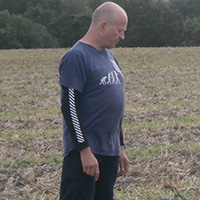
Mark has worked on over 100 different excavations since the 1980s, ranging in date from 5000 BC to the late 1800s. This makes the Queen’s Head one of the youngest sites he has dug. Both Mark and his Museum of Liverpool colleague Liz Stewart were confident they would unearth the birthplace of big time football on Merseyside, but at the same time they were aware that it’s not unusual to draw a blank.
Mark had warned me with the words: “Even with map evidence as good as we had for the Queen’s Head there are never any guarantees that anything will be found and there was always a possibility that everything, including the pub’s foundations, had been removed when the site was finally demolished in the 1960s.

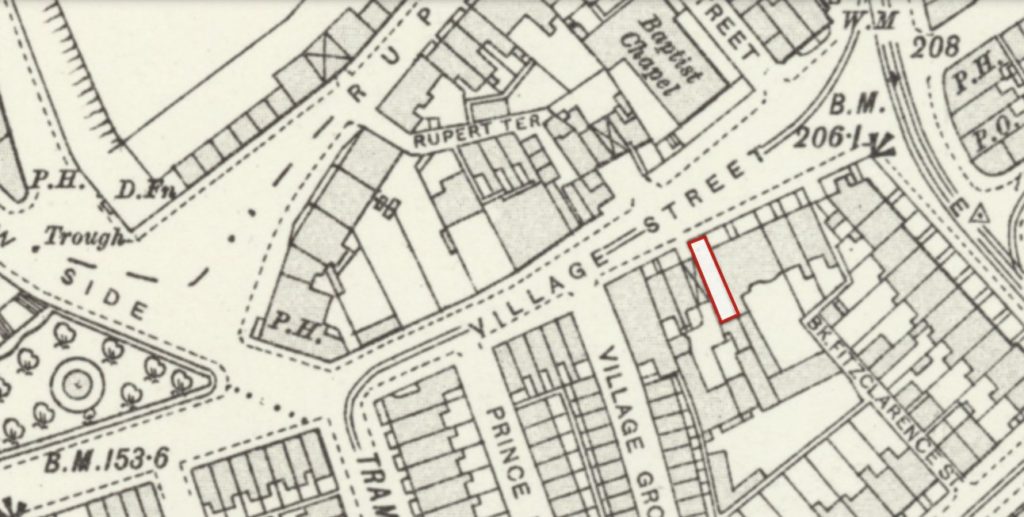

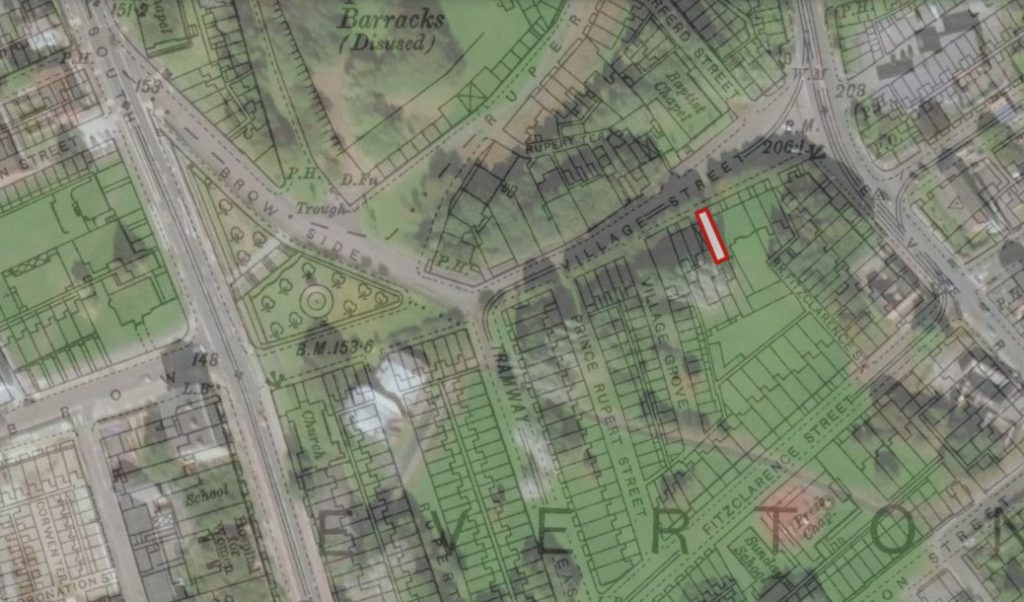
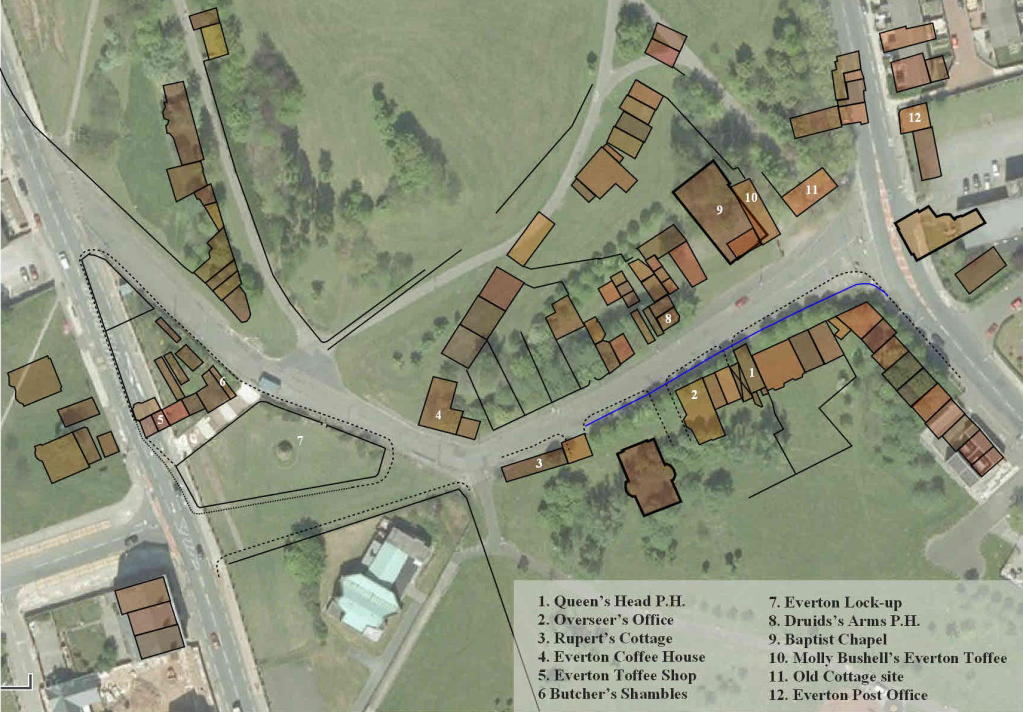
“Normally this is just part of the excitement of archaeology, but in this case there was also the risk of disappointing the hundreds of Evertonians who we knew would turn up on the day to watch the dig. Luckily no one was to go away feeling let down.”
The property that ultimately became the Queen’s Head was constructed around 1830, originally as a domestic house, probably one of the many ‘Beer Houses’ opened that year after the 1830 Beer Act allowed any Ratepayer to sell beer after paying 2 guineas for a license. Over 24,000 opened nationally in the year after the Act was passed. Most of these were in domestic terraces and often consisted of a single room. A lot of similar pubs were rebuilt in the later 19th century as a result of changing legislation and most of the remaining ones closed down between 1904 and the 1920s as regulations tightened. It’s therefore quite remarkable that the Queen’s Head building survived into the late 1960s.

Looking down Village Street with the Queen’s Head Hotel on the left facing the cross

The same site shown in the painting above by the 1960s, shortly before demolition
Mark’s experience indicated that if any remains of the pub had survived, they would be deeply buried. He said: “We were going to need something big to get to the remains in one day and to get the hole filled in again at close of play for safety reasons and to protect the site. Most people believe archaeology is all about painstaking work and patience, but sometimes you need the heavy brigade to help sort things out and we called in a 20 ton tracked excavator.

Everton Village by H Greenwood after W G Herdman
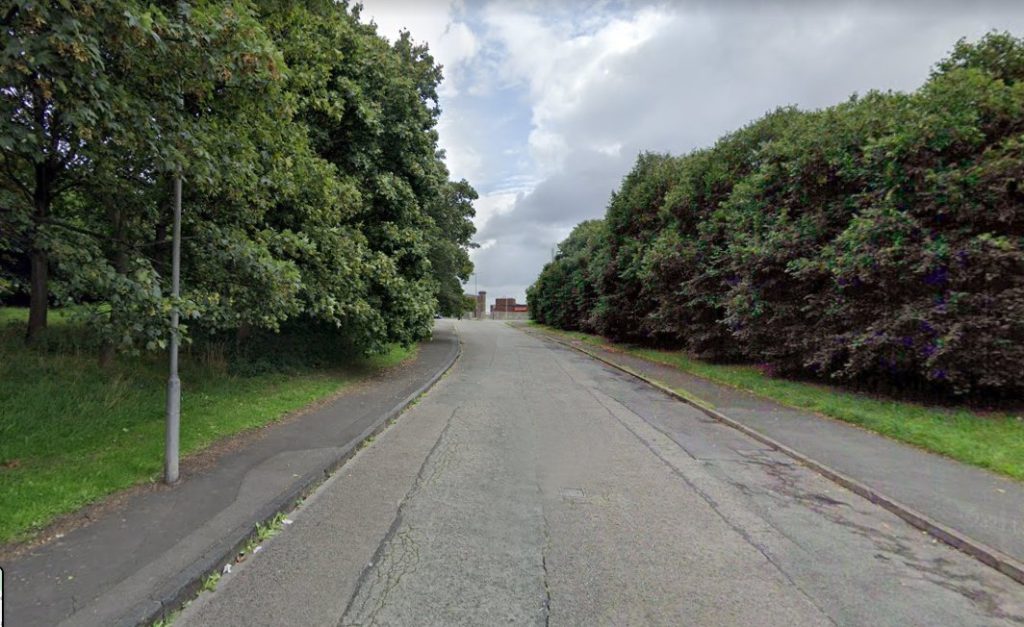
The Queen’s Head Hotel site halfway up on the right
“As it turned out the use of such a large machine wasn’t overkill. The remains of the Queen’s Head were covered by three separate layers nearly two metres deep in total. The upper metre was a layer of top soil, modern bricks and concrete laid down when Everton Park was landscaped in the early 1980s. Below that was another layer, about 0.75 m thick and mainly made up of hand-made bricks, containing the walls of the pub. This layer also had a few timbers, plus fragments of Welsh slate from the Queen’s Head roof and this was the first sign that we were close to touching Everton football history.”

Beneath this was a black layer, about 15 cm thick, mainly made up of coal dust and soot. Mark explained this came from the walls, floors and ceilings of the pub and represents the accumulated debris from about 130 years of coal fires in the building’s fireplaces. At the bottom of the trench were the intact foundations of the building where a royal blue football dynasty had begun to take shape.
Mark said: “Without excavating a much larger area it’s impossible to be 100 per cent sure, but we believe we found the front parlour of the Queen’s Head and therefore the most likely location for the bar area where that landmark name-change meeting would have been held.”
A small quantity of finds were recovered from the dig’s lower layers, mostly late 19th and early 20th century pottery, exactly the sort of material you would expect to find on the site of any Victorian house in central Liverpool (see gallery below). We know the Queen’s Head was later used as a Cow Keeper’s house to supply locals with fresh milk, later becoming a traditional dairy. It also housed the Everton Labour Club in the 1960s. Despite the pub’s later use, Mark said: “We unearthed a few items that are likely to be from the Queen’s Head. One of these is a fragment of decorative tile, possibly part of a small arch. Surviving photographs of the pub show a plain brick façade so it’s most likely to be from the inside of the building, probably the bar area.
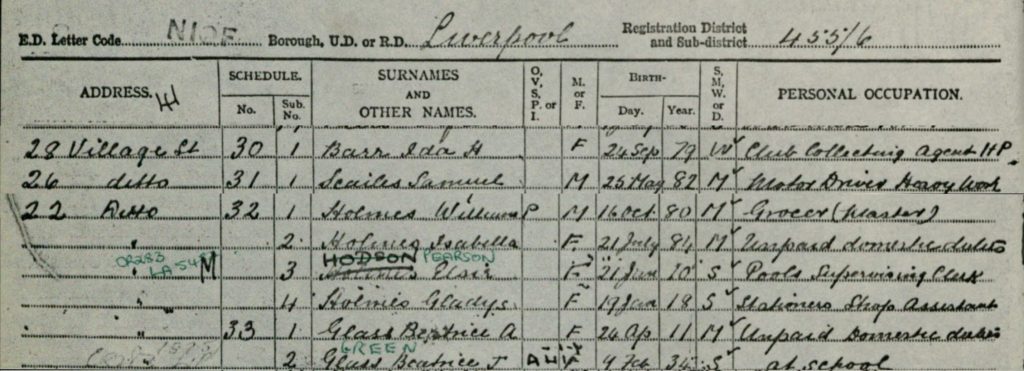
“Other items which are likely to relate to the building’s days as the Queen’s Head are oyster shells found in the demolition rubble.”
Today oysters are thought of as a food of the rich, but things were quite different in the 1800s when they would have been a common pub delicacy. A combination of overfishing and pollution resulted in rapidly declining stocks of the shellfish until by the 20th century oysters were rare and considered a luxury. Some of the other finds from the site are of the right date, but are harder to link directly to the pub.
A stoneware inkwell is of a type which is very difficult to accurately date. It is probably 19th century, but could be as late the 1940s. Mark said: “Of course, it would be great to think that we found the container for the ink used to write the minutes of that first Everton FC meeting.”
We can never prove it, but it’s occasionally nice to dream and even it proves that even archaeologists, who deal only in facts, can share a romantic vision!
Ken Rogers


II. Rewriting Everton FC History
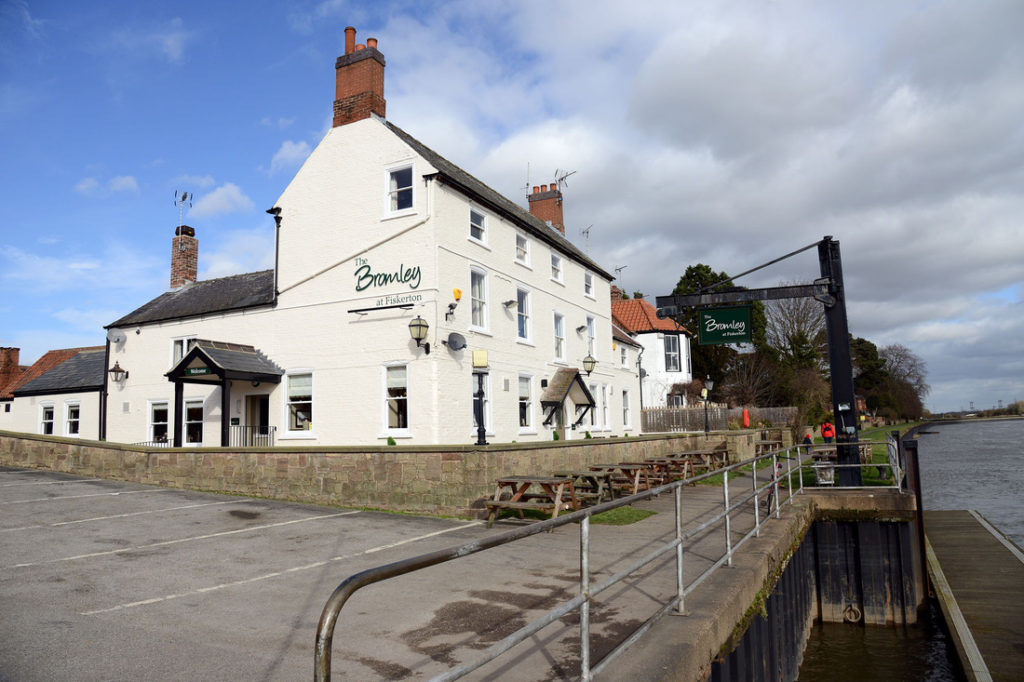
John Clarke, born in Amersham, lived in the village of Fiskerton in Nottinghamshire where he worked as a farmer. After he lost his wife Mary at a young age he moved in with his brothers and sister Elizabeth, who was licensee of the Waggon and Horses Inn. He clearly learned the trade, as by the late 1870s he had moved to Everton and was licensee, with his son John William, of the Queen’s Head Hotel in Village Street.
While preparing for the archaeological dig on Saturday, 18 July 2015 to find Everton FC’s spiritual roots at the site of the Queen’s Head Hotel in Village Street where St Domingo’s became the new Everton FC in 1879, I continued with my own people research and gained permission to study the files and records held at the respected city centre Athenaeum Club. This enabled me to review contemporary Victorian Street directories. These would not only tell me who was living at the Queen’s Head in 1879, but would also pinpoint the year it stopped functioning as a local pub.
Back home, I found myself reading a 1960s book on Merseyside football by Dr Percy Young who named Everton FC’s first secretary as John W. Clarke, describing him in time honoured fashion as the landlord of the Queen’s Head. As it turns out, Dr Young had got it half right. The middle initial – W – jumped out at me. I was now able to review official census files for the period, cross checking with the information I had secured via the street directories. This revealed that the Queen’s Head pub landlord was actually John Clarke and that it was 26 years old son, John William Clarke, living with his father at the Village Street licensed premises, who was Everton’s first secretary and who arranged that historic name change meeting.
This suddenly made absolute sense. Clarke the younger was well educated – initially a schoolmaster and then an engineer – well capable of handling meeting notes and organising games with increasingly bigger opposition. His father John would have been hectic in his pub on Saturday afternoons when the new Everton FC played in Stanley Park.


So not only did the archaeological dig help re-discover the birthplace of big time football on Merseyside, it also helped to correct a crucial chapter in our history in terms of the identity of Everton’s FC’s first influential club secretary.
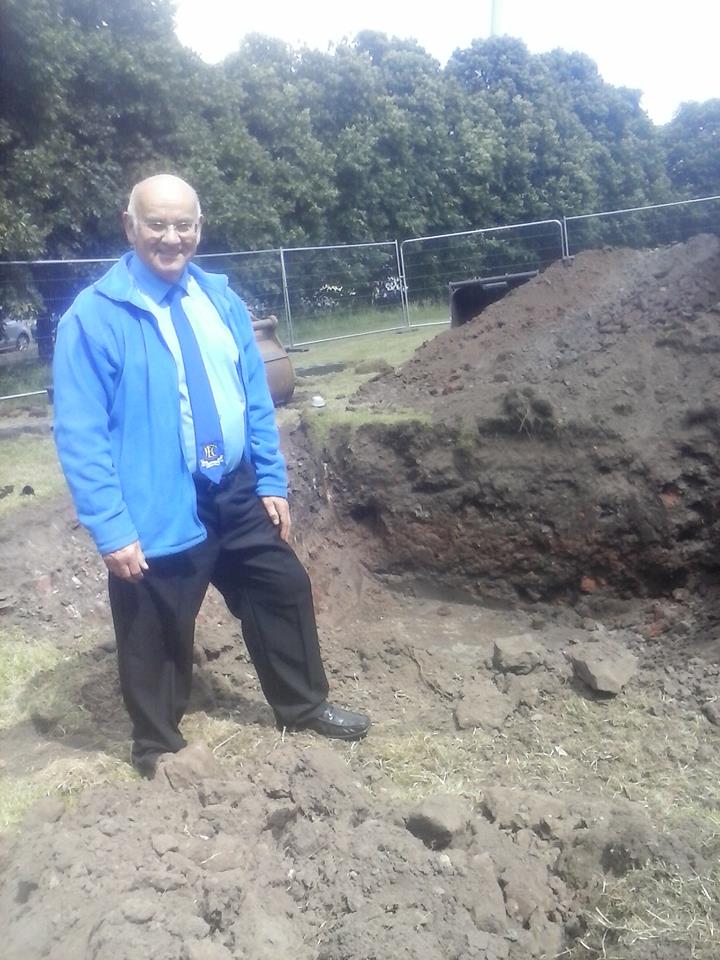
Peter Lupson, author of the excellent book ‘Across the Park’ which, in its own right, unearthed some previously unknown links between Everton and St Domingo’s, attended the dig with members of the Everton FC Heritage Society that now meets at the club’s historic Liver Building headquarters at the Pier Head.
Peter said: “I thought the dig was an outstanding and historic day. The locals who attended told me how proud they were to come from the community where the club was born. One lady said that she had lived just a stone’s throw away from the site for years and didn’t know the history of it.”

Peter described as “breathtaking” the moment the foundations of the Queen’s Head emerged from the deep trench unearthed by Liverpool Museum archaeologists Dr Mark Adams and Dr Liz Stewart. He said: “Suddenly we were looking into the parlour where, in 1879, the St Domingo’s football committee held that momentous ‘name change’ meeting. Some of the first players to turn out for the new Everton FC would have been in the room that night.”
Peter added: “For anyone with a pride in the history of the club, the excavation in Village Street was a truly emotional moment. I even took away a couple of bricks from the walls of the Queen’s Head, one for my son who is a big fan, and another for the Everton FC Heritage Society. When I got home I scrubbed them clean and they are now valued treasures of a defining moment in the club’s history.”
For me, a huge box had been ticked in terms of bringing club and district even closer together. As we prepare for our historic move from Goodison Park to Bramley-Moore, our Everton roots have never been so important. We were the first senior club in this city. We were pioneering founder members of the Football League. We have enjoyed more seasons in English football’s top flight than any other club and as far as I am concerned that makes us unique and very special indeed.
We were and will always be our city’s first football giants . . . genuinely the People’s Club and always respectful of those pioneers who remain a massive part of our history.
Acknowledgements
Both articles are extracted from Ken Rogers 2016 book ‘Born Not Manufactured’ – a great read for all Evertonians. Still available in Kindle digital format via www.amazon.co.uk
Ken, a member of Everton FC Heritage Society, began his career in journalism in the late 1960s and went on to become Liverpool Echo’s Chief Football Correspondent and Sports Editor. In 2001 he was named Northern Sports Journalist of the Year. He retired in 2014, but continues to research and write about his club.
Edited by Mike Royden, plus additional documents & picture research
Update May 2021
We have heard from one of the archaeologists who conducted the Queen’s Head dig, that Liverpool Museum, at some stage this year, are considering putting back on show some of the key artefacts from that historic occasion at which the Everton FC Heritage Society played such a prominent part. We have offered to support anything Dr Liz Stewart is ultimately planing for Liverpool Museum, and highlighted that the Society would almost certainly like to be involved.
Update January 2022
Some new 2022 information from author, statistician and Evertonian Billy Smith has confirmed Ken Rogers’ earlier research that John William Clarke was the individual who would have formally organised the historic name-change meeting at his father’s Queen’s Head Hotel, Village Street, Everton, in November 1979, at which the fledgling St Domingo’s chose to move forward as Everton FC. The Queen’s Head is therefore confirmed as Everton’s first headquarters and the birthplace of big-time football on Merseyside with Clarke Jnr the club’s first secretary.
Billy was researching some notes, published in the Liverpool Echo on Friday, 31 August 1928, in which a Mr W. Eyton was responding to a previously published letter from former Everton half-back Mike Higgins who played in those early pioneering days. In 1888, Mike was the first Everton player to receive a testimonial for ten years service.
Mr Eyton said that Mike was famous, not only for his football, but his curly hair. He recalled a photograph that fittingly hung in a local hairdresser’s, showing Mike wearing his county cap with black velvet and silver tassel, adding: “I would like readers to know that Mike has many stories to tell about the formation of Everton Football Club and enjoyable evenings spent after matches at the expense of the team.”
Clearly, Duncan Ferguson was not the first to have put money behind the bar at a local pub! The pioneers appear to have been quite generous in terms of our earlier supporters.
These evenings would have been at the Queen’s Head Hotel, confirmed by a follow-up letter in that 1928 Echo edition from a second correspondent, Harry Williams, who wrote: “I knew Mike Higgins intimately. He was a most versatile player, one of the best. There was mention of Clarke’s (Queen’s Head) pub, the first headquarters of the club. Young Clarke was secretary (not his father who was the pub landlord). The house has long since ceased to operate as a pub. There used to be weekly wrestling bouts in the building at the rear.”
Many thanks to Billy Smith for turning up this fascinating Echo research to add to, and confirm without any doubt, Ken Rogers’ view that EFC’s first secretary was the younger 26 years old John William Clarke, and not his landlord father John, who, down the years, had often been incorrectly credited with having had that historic role.
And a thank you to Peter Lupson who had the initial contact with Billy Smith on this issue.
Ken Rogers
Archaeological Excavation Gallery

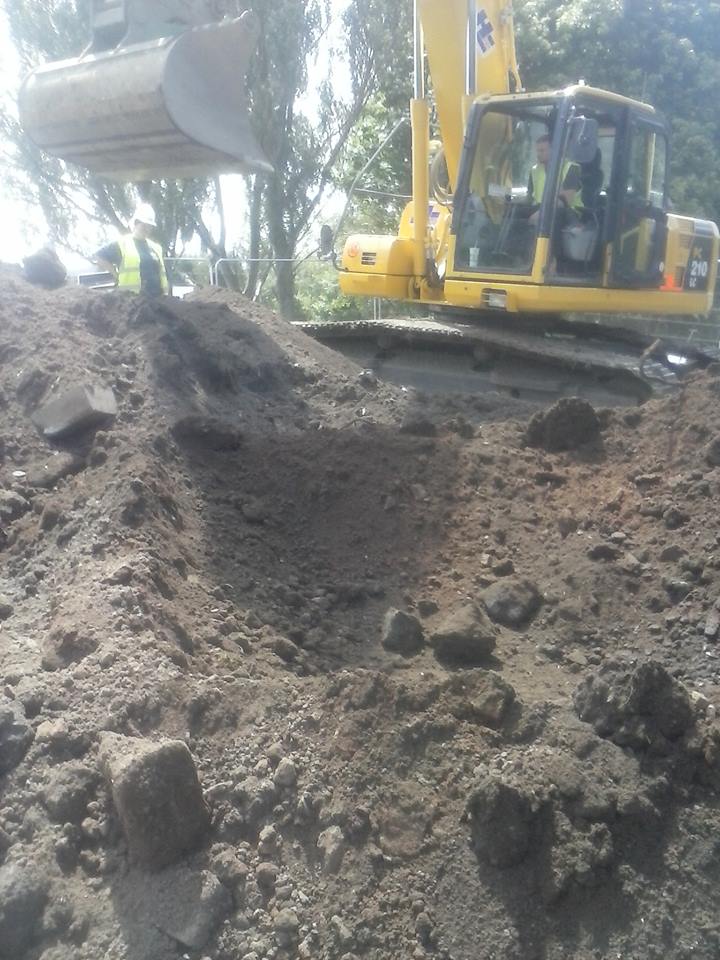
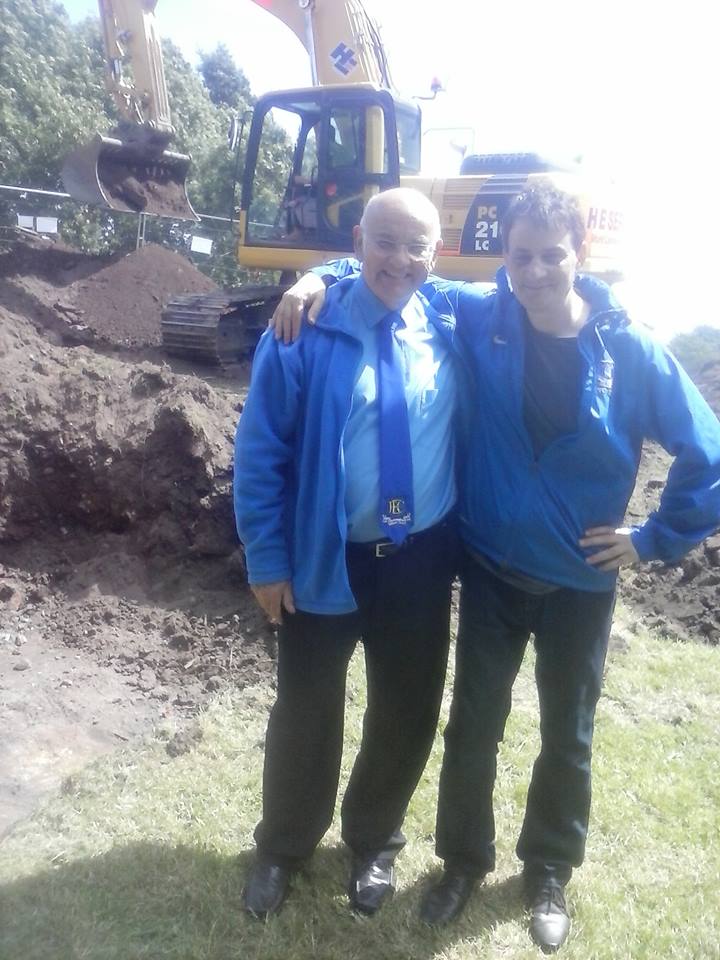
Peter with former EFCHS member Billy Smith (The Blue Correspondent) 

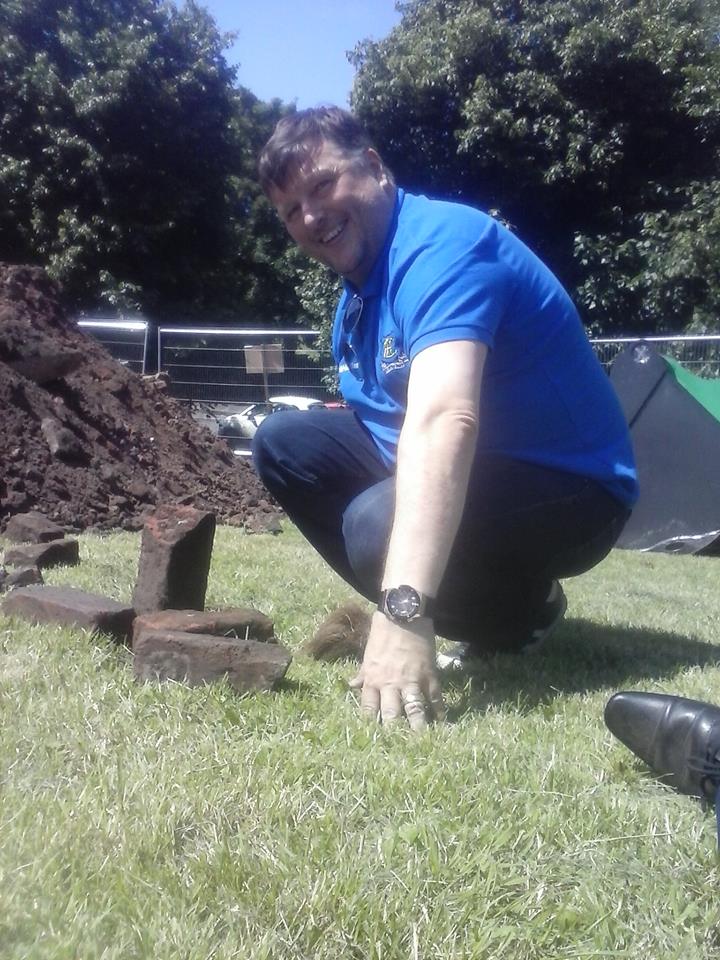
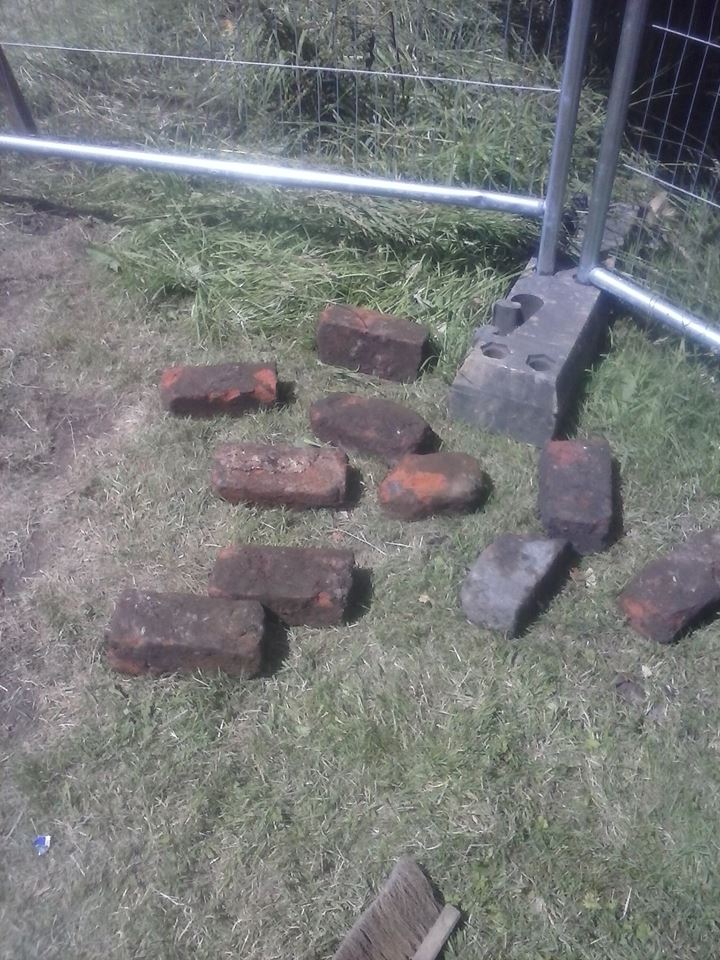


EFCHS Secretary Richie Gillham remembering his youth as a Lego expert 



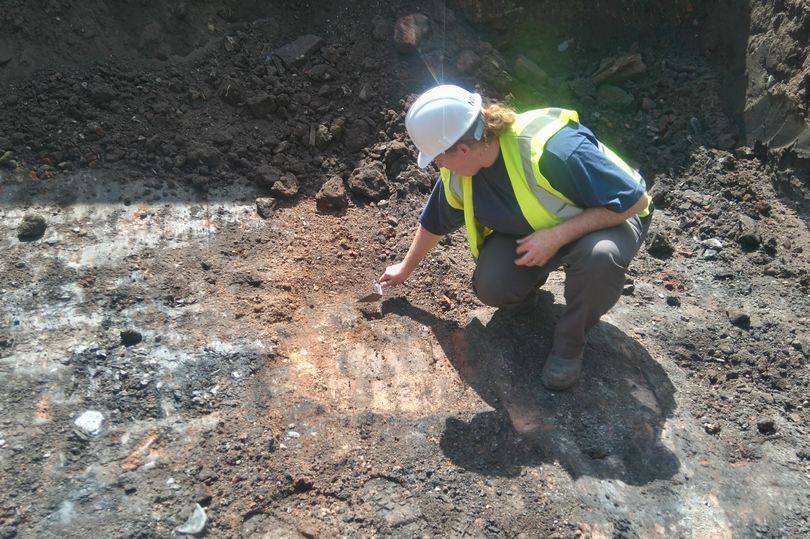
Dr Liz Stewart hard at work 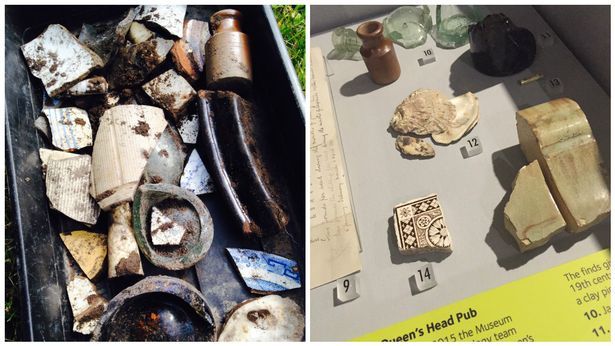
Some of the many finds

Additional Articles
Museum of Liverpool
We dig football!
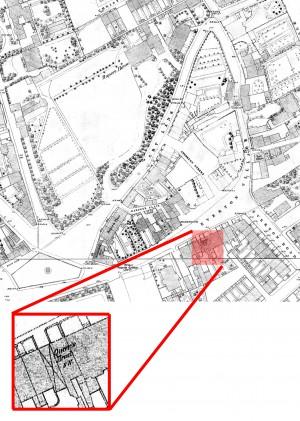
This weekend, on Saturday 18 July 2015, our archaeologists will be heading out looking for a pub – but this one won’t serve them a pint, it’s the site of an important historical event, and is under the ground!
The Museum of Liverpool archaeology team will be leading a community excavation in search of the Queen’s Head, Village Street, Everton in partnership with Friends of Everton Park . We’re looking to find the spot where the agreement was made to rename St Domingo’s Football Club – it became Everton FC in 1879, and from this time grew in size, and became a founder member of the Football League in 1888.
Local historian and former Liverpool Echo sports editor Ken Rogers, author of the best-selling ‘Lost Tribes of Everton’ books has undertaken considerable research about the building, and has discovered that the pub was used for club meetings as Everton’s first secretary John W Clarke was the son of the landlord. Map evidence suggests that the Queen’s Head was built around the 1830s, possibly originally as a house. At some point the ratepayer at the house paid their 2 Guinea for a license under the 1830 Beer Act, and were able to sell beer, developing the house into a pub. The building may only have had one room on the ground floor, but maps also show that there was also a paved area in front which might have been used.
Ken’s research shows that while the football club went from strength to strength, the old pub didn’t: its last landlord was Edwin Pike who closed it in 1895 in the face of increasingly strict legislation on pubs. The property lay empty for two years until, in 1897, it began to deal in milk instead of beer. Mrs A Sutton, described as a Cow Keeper, moved in with her animal/s and started one of many urban dairies supplying fresh milk locally. The dairy continued to operate, under the name Holmes Dairy until around 1960.
This excavation is part of the Walk on the Wild Side event across Everton Park and we’re hoping it may be able to locate the building, and help us learn more about its size, structure, and functions. Everyone’s welcome to come along and enjoy the day’s events, see what we’ve found and perhaps even try your hand at a bit of digging – we’ll be just off Village Street 10am-4pm on Saturday 18 July.
From the Museum of Liverpool website: www.liverpoolmuseums.org.uk/stories/we-dig-football
Daily Post
Everton FC have never played in Everton… so why the name?
by Ken Rogers
Liverpool Echo
Everton’s original home uncovered for the first time in half-a-century – Queen’s Head Hotel excavated
By David Prentice
The Lost Tribe of Everton
The birth of big time football on Merseyside
By Ken Rogers
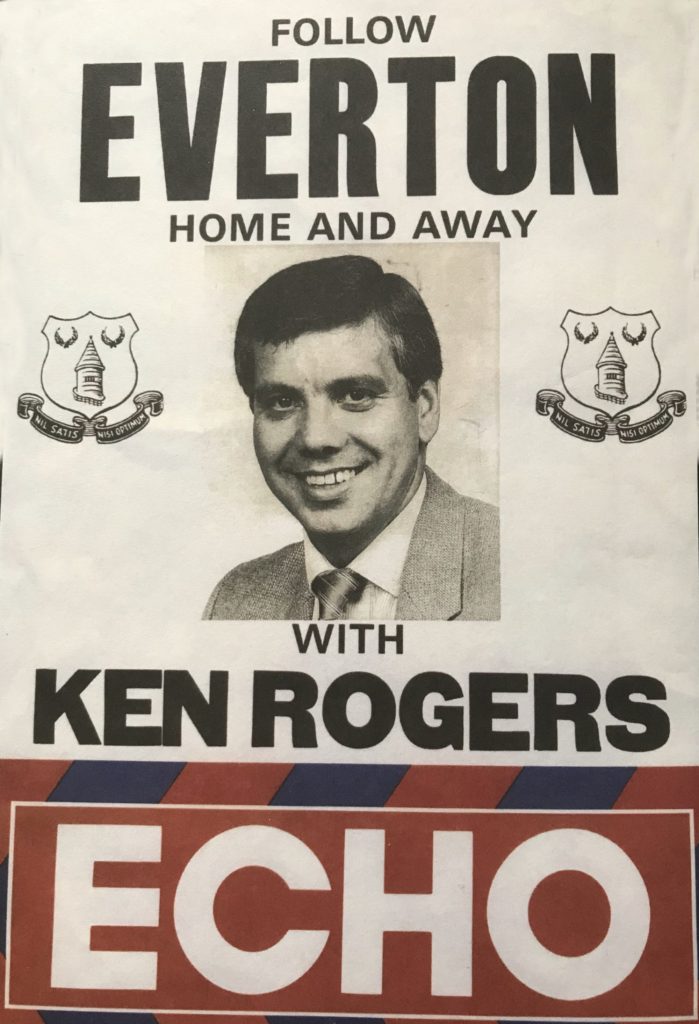
One of the archaeological finds – a rare poster dating from 1879 discovered in the foundations of the Queen’s Head Hotel site!
Ken’s actual first mention in Everton FC circles was in our famous 1969/70 Championship season when he contributed a piece for the home programme against Newcastle United as we headed towards the title. Of course, he covered many of the games in our most successful decade, the 1980s, and continues to write and researching club matters for the Everton FC Heritage Society.


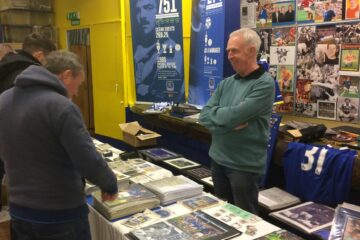
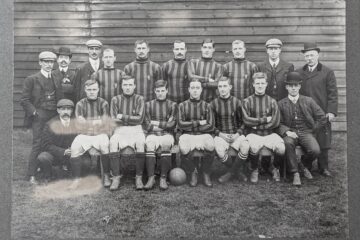
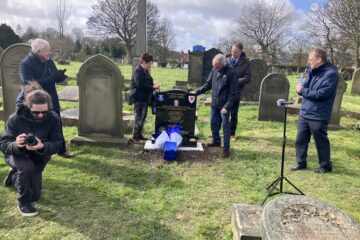
Born and bred in Anfield Liverpool. Now living in OZ but still following Everton and blown away with everything you write about Liverpool and of course Everton.
Looked at the Video this morning where you explain the ‘meeting at the well known pub’ I wanted to send the video with your permission to a friend, but there is NO way to share it either through Twitter and or Face Book.
How can I send the Video? it is so interesting, for me too. Sadly my husband passed away so it was so sad he didn’t see that Video. Please can you help? I would really appreciate it.
Hello Norma, Many thanks for your kind comments, glad to see you are still keeping in touch down there in Oz. I’m not sure which video you mean, can you be more specific as to what page or article this appears in, then hopefully we can sort a link for you. Regards, Mike Royden (webmaster)